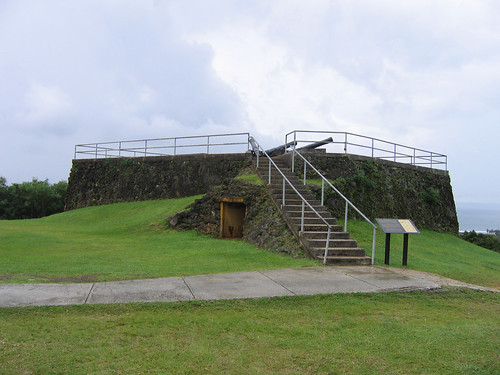At Apugan Hill, overlooking Hagåtña
Fort Santa Agueda, the only surviving Spanish fort in Hagåtña, sits atop Apugan Hill on the western coast of Guam. The fort, now commonly called Fort Apugan, provides a commanding view of the capital village of Hagåtña, the Philippine Sea, and the sheer northern clifflines of Oka Point and Urunao Point. The fort is also in a prime location to study the northern topography of the island with its raised limestone plateau. During the Spanish era, however, the site was developed for tactical purposes.
Built in 1800 using mampostería
The fort was built during the administration of Governor Manuel Muro (1794 – 1802). Construction of the fort was spurred by orders from Spain for all governors to reinforce the defensive capabilities of the empire against Britain. The fort was completed in 1800 and is named in honor of Muro’s wife, María Agueda del Camino. The fort was constructed from stone rubble, known as mampostería, which is a CHamoru construct of Spanish origin. The terreplein, a level space behind the parapet or wall, was created with a mixture of loose gravel and sandy soil. The parapet, approximately five feet tall, was built on the raised terreplein.
The fort was equipped with embrasures for ten small cannons, which were faced toward the Hagåtña Bay channel. Muro selected Apugan Hill as a fortification site to protect the low lying Governor’s Palace and Fort San Rafael, which were prone to hillside assaults. Spanish governors were concerned with the possibility of English privateers pillaging the colony or capturing vessels involved with the lucrative galleon trade.
One of the earliest historical references to the fort was written by William Haswell in 1802. Haswell, a Spanish-speaking first officer aboard the chartered American whaler, Lydia, reported seeing seven cannons and 10 men stationed at the fort. Shots were fired from the fort as a salute when Vicente Blanco, the Spanish governor who replaced Muro, first entered the church in Hagåtña.
Forts not needed after Galleon trade falls off
Throughout the 19th century Spanish governors had a difficult time maintaining Guam’s fortifications. The end of the galleon trade about 1815 – due primarily to the Mexican Revolution – brought economic hardships to Guam as supplies and finances became scarce. Spain was no longer benefiting from Mexico’s silver and the nation had incurred a tremendous war debt.
In 1817 Russian commander Otto von Kotzebue, aboard the Rurik, reported that Santa Agueda had only a few guns with no powder. In 1853 Governor Felipe de la Corte reported that the fort had the capacity to house fifty pieces of artillery, but was scarcely protected except for a nine-foot railing. In 1871 Governor Louís de Ibáñez y García judged the fort to be useless and in 1887 Governor Francisco Olive y García also questioned the fort’s effectiveness.
Americans use as a signal station
During the early American era, the fort was used as a signal station for ships. In 1933 the area was cleared, a road was constructed and it was proclaimed a naval government park. In 1942, during the Second World War, the Japanese recognized the strategic location of the fort and built a gun emplacement on the site. Japanese characters can still be observed embedded in the concrete.
Currently the site belongs to the government of Guam and is maintained by the Department of Parks and Recreation. All that remains of the fort is a raised viewing platform, but the site is one of the most frequently visited parks by tourists given its unobstructed view of Guam’s scenic western coast.
For further reading
Beaty, Janice J. Discovering Guam: A Guide to its Towns, Trails and Tenants. Tokyo: Tokyo News Service, 1967.
Degadillo, Yolanda, Thomas B. McGrath, SJ, and Felicia Plaza, MMB. Spanish Forts of Guam. MARC Publications Series 7. Mangilao: Richard F. Taitano Micronesian Area Research Center, University of Guam, 1979.
Driver, Marjorie G., and Omaira Brunal-Perry. Architectural Sketches of the Spanish Era Forts of Guam: From the Holdings of the Servicio Historico Militar, Madrid. MARC Educational Series no. 17. Mangilao: Richard F. Taitano Micronesian Area Research Center, University of Guam, 1994.
Guam Department of Parks and Recreation. “Guam State Historic Preservation Office.”
Guam’s Natural, Cultural, and Historic Sites Guidebook. Tumon: Guam Visitors Bureau, 2005.




